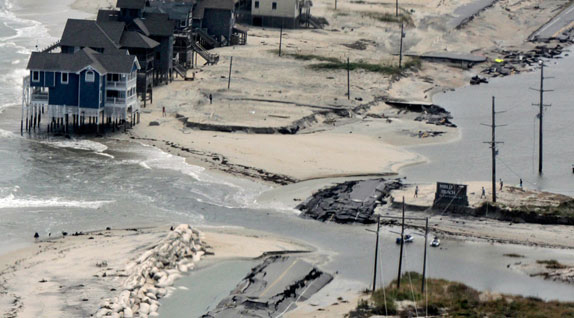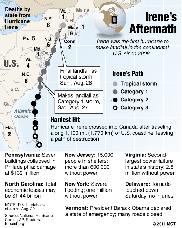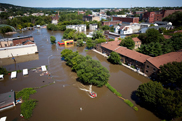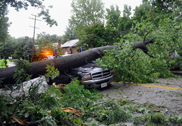 Chris Seward/Raleigh News & Observer/MCT
Chris Seward/Raleigh News & Observer/MCT
Article
While the storm dissipated above the North Atlantic Ocean, its real impact on the nation had only just begun.
Learn the why behind the headlines.
Subscribe to the Real Truth for FREE news and analysis.
Subscribe NowAs rays of sunshine appeared over New York City—an area broadsided by a massive storm system just hours earlier—sighs of relief were overshadowed by complaints that Hurricane Irene’s impact had been grossly exaggerated.
There were no 100-mph winds that blew out windows, no complete submerging of the subway system, no shutdown of all electrical circuits across the city. Tens of thousands of residents were not trapped in high-rise buildings—buses and ambulances were able to traverse streets that were not inundated with floating garbage and debris. Schools and hospitals were not shuttered indefinitely, and millions of residents were not told to stay home from work for weeks.
Instead of being overcome by waist-high water, New York City’s Times Square was filled with revelers sliding headfirst through six-inch puddles and boasting about “survival kits” they compiled consisting largely of vodka and cookies. Cheering crowds of 20-somethings waving cellphone cameras gathered in the streets as a visiting hockey team pulled out their sticks and began playing in the intersection.

The mass evacuations and emergency precautions seemed to be for nothing—mere scare tactics by a government determined to cover itself.
“Some New Yorkers complained that the hurricane—actually a tropical storm when it reached the city—had been overblown, but many others praised [Mayor Michael] Bloomberg,” Forbes reported.
After the storm died down, many felt the city would spring back to life with minimal traffic delays. Instead of being concerned, people thought: Why all the fuss?
The title of a Telegraph article summed up a prevalent attitude: “Perfect Storm of Hype: Politicians, the media and the Hurricane Irene apocalypse that never was.”
“With all the preparations and all the hoopla on TV, it was all for naught,” one New York resident told The New York Times. “I feel embarrassed that we made such a to-do.”
The thought of the world’s financial capital suffering a catastrophic deluge caused journalists and newscasters to flock there. This meant that when Irene did not deliver its “worst-case scenario” for New York City, the majority of news coverage reported that the storm had been overhyped.
Yet this was only one area hit along the United States East Coast. Others did not fare as well.
Path of Destruction
For residents elsewhere, warnings came too little, too late. Hurricane Irene left them devastated, their 200-year-old houses carried away by powerful streams-turned-raging rivers during the country’s worst floods in 100 years.
 Michael Nagle/Getty Images
Michael Nagle/Getty Images “It never became the big-city nightmare forecasters and public officials had warned about, but it caused the worst flooding in a century in Vermont,” USA Today reported.
The storm that affected more than 65 million people in 11 states along the East Coast, pummeled several major metropolitan hubs, resulting in at least 40 deaths, 2.4 million evacuees, 9,000 canceled flights, approximately six million homes and businesses without power, and an estimated $7 billion in overall losses plus $3 billion in insurance coverage.
Are these numbers “overblown”?
“It’s very serious for us at the moment in Vermont,” a Vermont Emergency Management Agency spokesman said in a BBC article. “The top two-thirds of the state are inundated with rapidly rising waters, which we anticipate will be an issue for the next 24 hours.”
From North Carolina to Maine, similar stories emerged following Irene:
- “An apparently vacant home exploded in an evacuated, flooded area in Pompton Lakes, N.J., early Monday, and firefighters had to battle the flames from a boat,” The Associated Press reported. “In the Albany, N.Y., suburb of Guilderland, police rescued two people…after their car was swept away. Rescuers found them three hours later, clinging to trees along the swollen creek.”
- “Fairfield [New Jersey], a town 25 miles west of New York City that is surrounded on three sides by the curving Passaic River, was in danger of becoming an island, said Armando Fontoura, the Essex County sheriff and the county emergency management coordinator…‘The worst is yet to come for us,’ Fontoura said. The river could rise as high as 23.6 feet, said Fairfield Deputy Police Chief Anthony Manna, breaking the record of 23.2 feet set in 1903 and topping a more recent high of 22.9 in 1984” (Reuters).
- “Between 15 and 20 heating-oil trucks were pushed into the Ramapo River after a 9-inch torrent of rain fell near Tuxedo Park, N.Y., and the stream overflowed,” The Wall Street Journal reported. “‘An environmental disaster is floating down the river,’ said Mayor Tom Wilson in an interview. There’s fuel spilling into the river...It’s everywhere.’”
- In North Carolina’s Outer Banks, “a highway linking the islands was broken in five places. A new inlet, an estimated 200 feet wide, cleaved northern Hatteras Island” (The Charlotte Observer). Approximately 2,500 survivors were trapped there after the storm.
- A Massachusetts man was electrocuted after a large tree “fell on high-tension lines during the storm, causing a line attached to a utility pole in front of the home to land on the roof. That, in turn, apparently electrified the aluminum-trimmed railing on the porch,” and killed him (The Associated Press).
- In Virginia, at least four people were killed by falling trees, including an 11-year-old boy.
Some could not resist the urge to profit from others’ misfortune.
 Chuck Liddy/Raleigh News & Observer/MCT
Chuck Liddy/Raleigh News & Observer/MCT“Police say the two men stole alcohol and an iPod speaker system from a home…It happened shortly before 4:00 Saturday afternoon as 13News was reporting live at the scene where several homes had been damaged during a small tornado. It turns out, the photographer caught the looters on video…” local television station WVEC reported.
As residents struggled to clean up parts of the 1,100-mile disaster zone of toppled trees, washed-out roads, and scattered debris, many came to the realization that the storm—while not as powerful as originally feared—could still turn out to be worse than anticipated once it had passed.
“…officials warned of the possibility of severe flooding over the next few days as runoff from the storm makes its way into creeks and rivers,” The Associated Press reported. “In some parts of the Northeast, the ground was soggy even before the storm because of an extremely rainy August.
Of the flooding, Pennsylvania’s governor warned: “This isn’t just a 24-hour event.” Other officials cautioned that the country should not yet feel it had “dodged a bullet.”
Unpredictable Conditions
While people may scoff now, the dire predictions for New York City and other areas were founded on solid evidence.
“In the annals of natural disasters, it doesn’t get much worse than a major hurricane directly striking New York City and Long Island,” Reuters stated, adding, “People still talk about the Long Island Express of 1938, a Category 3 storm that the U.S. government has said would cause $40 billion in damage if it hit today.”
“Going back to 1851, there have been only 5 hurricanes whose centers of circulation have passed within 75 miles of New York City,” The Weather Channel reported. “The last hurricane within that distance from New York City was Hurricane Gloria 26 years ago.”
 Jeffrey F. Bill/Baltimore Sun/MCT
Jeffrey F. Bill/Baltimore Sun/MCTNew York state’s infrastructure is in need of a serious overhaul: 46 percent of major roads are in poor or mediocre condition, 45 percent of major urban highways are congested, and 42 percent of bridges are structurally deficient or functionally obsolete, according to an American Society of Civil Engineers report.
Even with the tropical storm status, Irene caused 100-year floods, historic evacuations, and shredded entire houses. What would have happened with a Category 2—let alone a Category 3?
Before Irene hit, a Popular Mechanics article detailed a worst-case scenario based on an Army Corp of Engineers report and Department of Homeland Security research: “As the eye of the storm passes over Staten Island, the 100-mph counterclockwise winds shove 500 million tons of seawater directly into the harbor. The narrowing shorelines and shallowing sea bottom cause the mass of water to build. By the time the storm surge washes over the shores of Brooklyn, Queens and Manhattan, it towers 11 to 15 feet high.
“Water flows through New York’s financial district and reaches 2 miles into southern Brooklyn and Queens, flooding 2900 miles of roads. Impromptu rivers gush into subway stations and pour through hundreds of sidewalk gratings.
“In Manhattan, the lower levels of Penn Station and Grand Central fill with water. The subway floods within 40 minutes—paralyzing the city’s chief form of public transportation. Three of the four automobile tunnels linking Manhattan to the outer boroughs and New Jersey also flood, submerging hundreds of cars stranded in traffic jams during evacuation. A million people lose electricity and phone service as floods shut down 10 power plants and the emergency generators powering cellphone towers.”
The nation’s crumbling infrastructure systems also worsened damage to other areas hit hard by Irene. Consider washed-out major highways in Vermont, destroyed piers in North Carolina, and sewage that seeped into water systems in Virginia.
Just because this storm did not cause the level of damage anticipated this time does not mean Long Island can withstand a full-force hurricane. If anything, after being battered by winds and flooding, New York and the East Coast come out worse-off, with weakened bridges, roadways, and dams.
With this in mind, were the predictions about Hurricane Irene really unwarranted?
Looking Ahead
Meteorologists cannot predict exactly when a hurricane will strike. While they can understand the conditions for a hurricane, and other weather patterns, they never can forecast a certain outcome. Hurricane Irene was no different. While experts almost perfectly determined Irene’s path, their calculations on the storm’s intensity was off. Instead of roaring into Manhattan as a Category 2, to many, it seemed to saunter through the city as a pesky rainstorm.
Yet this should not downplay the very real casualties left in Irene’s wake. Death and destruction should always make a person stop and consider: “Where did we go wrong?” “What could we have done differently?”
More important, “What about next time?”
In reality, Tropical Storm Irene is really a tiny piece of a larger picture.
Consider what has happened just this past summer: a 5.8 earthquake near Washington, D.C.—a swarm of 800 tornadoes across the Bible Belt—a historic drought in Texas—wildfires across Arizona and New Mexico—the Mississippi River flooding southern towns—the list could go on.
While weather disasters have always occurred, can you remember when such events have all occurred in rapid succession?
“According to the National Oceanic and Atmospheric Administration, the U.S. has so far experienced nine separate disasters, each with an economic cost of $1 billion or more—tying a record set in 2008. (Usually, the U.S. experiences three to four billion-dollar weather events a year.),” Time magazine reported. “Beyond the cost—which adds up to about $35 billion so far—at least 589 people have died in those events…”
Read that again: 2011 has had “nine separate disasters, each with an economic cost of $1 billion or more”—Hurricane Irene makes 10.
Meteorologists and journalists have noticed something strange is occurring. Reuters reported: “No question about it: this has been a wild weather year so far in the United States, with record rains, droughts, wildfires and tornadoes.”
“This is the first time an earthquake and a hurricane in the same week has forced east coast residents to evacuate buildings,” Discovery News stated.
As with pinpointing what determines the path and intensity of a hurricane, experts cannot explain why there are such turbulent conditions across the globe.
Searching for Answers
Most naturally want to know what is coming. They look to meteorologists for weather forecasts, seismologists for an idea of when the next sizable earthquake will occur, and economists to know their financial futures.
Others want to know where their lives are headed. They look to psychics, seers and prophets—always with poor results.
Yet something is definitely wrong.
People also look to Bible prophecy in an attempt to attach meaning to events, but with results every bit as poor as psychic readings and horoscopes. Here is why: most mangle what the Book says, inserting their own ideas, rather than believing what the Bible actually states.
Due to the errors of so-called prophecy experts, the future remains hazy—as does the meaning behind Hurricane Irene ravaging the East Coast. Yet, by allowing the Bible to interpret itself, you can understand what is occurring.
In the book The Bible’s Greatest Prophecies Unlocked! – A Voice Cries Out, David C. Pack offers a detailed explanation—backed by Scripture—of why certain news events and weather conditions are occurring:
“With world trends and conditions growing more frightening by the day, millions are searching—wondering about the course of events, and whether the world is on the brink of destruction.
“Jesus’ disciples wondered the same thing almost 2,000 years ago, and asked Him about the ‘end of the [age]’ (Matt. 24:3)…the prophet Daniel spoke of ‘the time of the end’ (Dan. 11:40; 12:9). The apostle Peter foretold, ‘There shall come in the last days scoffers’ (II Pet. 3:3)…Paul warned, ‘In the last days perilous times shall come’ (II Tim. 3:1). The last verse makes the subject more serious.
“Has this final interval in world history arrived? Can you be sure? You can—in fact, God expects you to know!
“Many sense or even firmly believe that we are in the last days. We hear from them daily. But these have rarely sought to prove this. They can—and should—know whether we are. So must you.
“Let’s pull back and look at the big picture. It has become painfully obvious that this world is in terrible trouble. Mankind is overwhelmed with every kind of trouble, evil and ill—war, terrorism, violence of every kind, famine, disease, pollution, overpopulation, political upheaval, religious confusion and tremendous economic turmoil and decline, which we saw is threatening to make the Great Depression look like child’s play. Then there are the hundreds of millions who live in abject poverty, ignorance and oppression. Now add rampant and worsening immorality and perversion in every Western nation—and growing hatred, unrest and the already-discussed never-ending cycle of war in the Middle East—and deteriorating conditions throughout Africa—and earthquakes, volcanoes and frightening weather patterns across much of the world—and devastating fires, tornadoes, hurricanes, drought and floods occurring with greater frequency and intensity—and headlines screaming of murder, rape, robbery and crimes of every kind.
“These mushrooming problems now threaten all nations.
“Is all of this really only a little temporary worsening of what is otherwise ‘business as usual’ for planet Earth? Many more—and much louder!—are the voices that say no, and that time is running out to solve the really big problems facing the world. More world leaders are expressing concern about the rise of division within and between nations. So are other voices of authority in education, the military, science and sociology. Yet, because this is also an age of religious sundowners and doomsayers, most will not pay real—serious!—attention.”
Disaster Upon Disaster
Where does Hurricane Irene fit into all this? Notice Mark 13, which also is in the context of the last days: “There shall be famines and troubles...” (vs. 8).
The word “troubles” is translated from a Greek term that means “disturbance, that is, (of water) roiling, or (of a mob) sedition: trouble.” While this can certainly include the riots in England, the Arab Spring, and narcotics war in Mexico—it also implies an increase in floods, tremendous hurricanes, cyclones and typhoons, and other severe storms—which are all forms of “roiling water.”
In addition, the Old Testament of the Bible details another end-time trend: “Mischief shall come upon mischief, and rumor shall be upon rumor” (Ezek. 7:26). Here, the antiquated language hides the true meaning of the phrase. In the original Hebrew, “mischief” means ruin and disaster; “rumor” can also be translated news and report.
Look at headlines from a single day. You will find there is tragic news report after tragic news report! Before one set of crises is addressed, another smashes into the world. This is particularly true for the United States.
Hurricane Irene exemplified the weakness of America’s crumbling roads, antiquated sewer systems, and outdated power grids. As disasters and ruin pile upon one another, the infrastructure (which once kept the nation safely running) will only worsen each calamity—as will the country’s ability to pay for such disasters.
Consider Hurricane Irene’s recent impact on the federal government: “With less than $1 billion currently available for federal disaster assistance, the Federal Emergency Management Agency is temporarily suspending payments to rebuild roads, schools and other structures destroyed during spring tornadoes in Joplin, Mo. and southern states in order to pay for damage caused by Hurricane Irene,” The Washington Post stated.
How long can America keep paying for these compounding disasters?
As more weather-related disasters strike the U.S. as never before, a prevalent attitude will surface. Notice: “…there shall come in the last days scoffers …” (II Pet. 3:3).
When presented with the facts of what is foretold to come, many will laugh and mock. God knew this and recorded their snide response to Bible prophecy in the next verse: “Where is the promise of His coming? For since the fathers fell asleep, all things continue as they were from the beginning…” (II Pet. 3:4).
Do not allow yourself to fit into this category! Do not deceive yourself into thinking the constant barrage of earthquakes and weather upsets is normal.
In these last days, people will claim that what is occurring is “no big deal,” “overblown” and “exaggerated.” Hurricane Irene shows that many already feel this way!
The words of the Bible should be on your mind as the nation recovers from Hurricane Irene—as Joplin rebuilds after an F-5 tornado—and as monuments in the nation’s capital are repaired.
With each new report of tornadoes, earthquakes, hurricanes and other natural disasters, understand that you are witnessing a worsening scenario foretold millennia ago.
More on Related Topics:
- The Swarm of Earthquakes Shaking Santorini Prompts Greece to Declare an Emergency
- Nearly 250 Million Children Missed School Last Year Because of Extreme Weather, UNICEF Says
- What to Know About the Devastation from the Los Angeles-area Fires
- Los Angeles Wildfires Rage Out of Control, Testing Firefighting Resources
- A Quarter of Freshwater Animals Are Threatened with Extinction, New Research Shows


